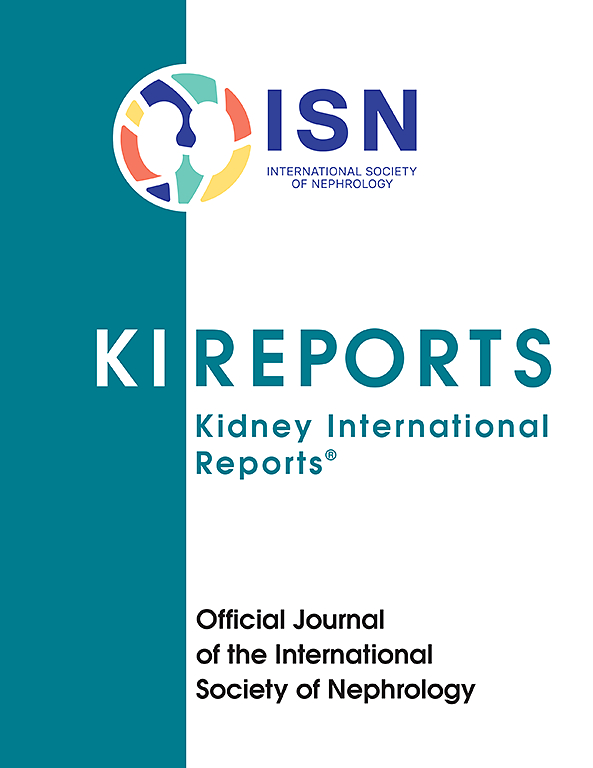Defining Relationships Among Tests for Kidney Transplant Antibody-Mediated Rejection
IF 5.7
2区 医学
Q1 UROLOGY & NEPHROLOGY
引用次数: 0
Abstract
Introduction
Effective therapies for kidney transplant antibody-mediated rejection (ABMR) will require accurate diagnoses plus assessment of ABMR activity, and the new tests that were used to show treatment effects in the clinical trial such as donor-derived cell-free DNA (dd-cfDNA) and molecular biopsy analysis (the Molecular Microscope Diagnostic System) could be useful.
Methods
Trifecta-Kidney (ClinicalTrials.gov #NCT04239703) studied 717 indication biopsies to define the relationships among the following 4 tests used for ABMR: (i) standard-of-care (SOC) local histologic biopsy ABMR diagnosis, (ii) MMDx ABMR diagnosis, (iii) dd-cfDNA, and (iv) donor-specific antibody (DSA).
Results
All 4 tests were correlated in a partial correlation network, with a hierarchy of intertest correlations: MMDx ABMR > dd-cfDNA > histology ABMR > DSA. Surprisingly, DSA correlated at least as strongly with MMDx ABMR as with histologic ABMR, even though DSA is not used in MMDx. When expressed in the same 6 rejection classes, MMDx diagnosed ABMR more frequently than histology. When histology disagreed with MMDx ABMR, dd-cfDNA and DSA correlated more strongly with MMDx assessment. However, histology also detected ABMR lesions in some cases that MMDx called No Rejection, correlating with subthreshold molecular ABMR activity, dd-cfDNA and DSA (AJT 25:72-87, 2024). Molecular rejection predicted graft outcomes better than histologic rejection in Trifecta-Kidney, and this finding was confirmed in the earlier INTERCOMEX study cohort.
Discussion
The 4-way intertest correlations extend below current thresholds for diagnosing ABMR. These results map a network of 4 ABMR-related tests that can add precision to ABMR assessment in trials and clinical management, and highlight the need to establish the clinical significance of subthreshold ABMR activity.

确定肾移植抗体介导的排斥反应试验之间的关系
肾移植抗体介导的排斥反应(ABMR)的有效治疗将需要准确的诊断和ABMR活性的评估,并且在临床试验中用于显示治疗效果的新测试,如供体来源的无细胞DNA (dd-cfDNA)和分子活检分析(分子显微镜诊断系统)可能是有用的。方法:strifecta - kidney (ClinicalTrials.gov #NCT04239703)研究了717例适应证活检,以确定用于ABMR的以下4项检测之间的关系:(i)标准护理(SOC)局部组织活检ABMR诊断,(ii) MMDx ABMR诊断,(iii) dd-cfDNA, (iv)供者特异性抗体(DSA)。结果4项检测均呈部分相关网络,相关程度依次为MMDx ABMR >、dd-cfDNA >、组织学ABMR >、DSA。令人惊讶的是,DSA与MMDx ABMR的相关性至少与组织学ABMR的相关性一样强,尽管DSA未用于MMDx。当在相同的6种排斥反应中表达时,MMDx诊断ABMR的频率高于组织学。当组织学与MMDx ABMR不一致时,dd-cfDNA和DSA与MMDx评估的相关性更强。然而,在一些病例中,组织学也检测到MMDx称为No Rejection的ABMR病变,与亚阈值分子ABMR活性、dd-cfDNA和DSA相关(AJT 25:72- 87,2024)。在triecta - kidney中,分子排斥反应比组织学排斥反应更能预测移植结果,这一发现在早期INTERCOMEX研究队列中得到了证实。4-way感兴趣相关性延伸到诊断ABMR的当前阈值以下。这些结果绘制了一个由4种ABMR相关测试组成的网络,可以在试验和临床管理中增加ABMR评估的准确性,并强调了建立阈下ABMR活性的临床意义的必要性。
本文章由计算机程序翻译,如有差异,请以英文原文为准。
求助全文
约1分钟内获得全文
求助全文
来源期刊

Kidney International Reports
Medicine-Nephrology
CiteScore
7.70
自引率
3.30%
发文量
1578
审稿时长
8 weeks
期刊介绍:
Kidney International Reports, an official journal of the International Society of Nephrology, is a peer-reviewed, open access journal devoted to the publication of leading research and developments related to kidney disease. With the primary aim of contributing to improved care of patients with kidney disease, the journal will publish original clinical and select translational articles and educational content related to the pathogenesis, evaluation and management of acute and chronic kidney disease, end stage renal disease (including transplantation), acid-base, fluid and electrolyte disturbances and hypertension. Of particular interest are submissions related to clinical trials, epidemiology, systematic reviews (including meta-analyses) and outcomes research. The journal will also provide a platform for wider dissemination of national and regional guidelines as well as consensus meeting reports.
 求助内容:
求助内容: 应助结果提醒方式:
应助结果提醒方式:


